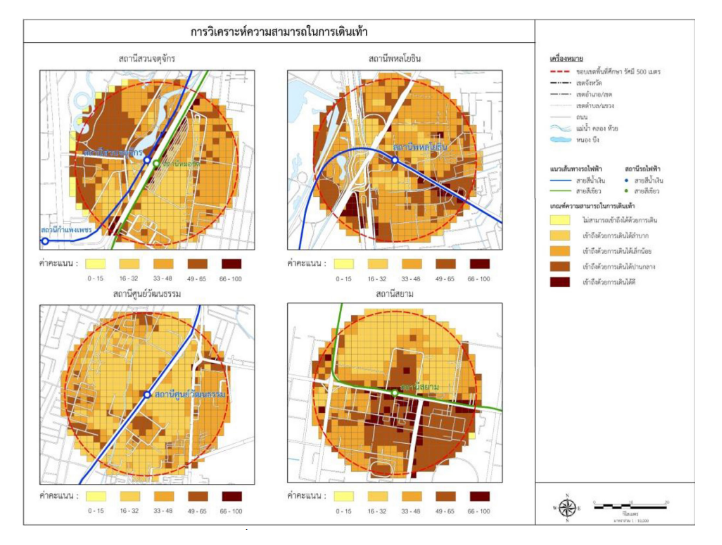The Analysis of Walkability Based on the Concept of Transit Oriented Development (TOD)
Main Article Content
Abstract
Pedestrian is a basic element for urban sustainability, however in Thailand, pedestrians are at a high risk of accidents while access to transit stations. This is due to the reason that road facilities in Thailand has not been designed to support vulnerable road users. The purpose of this research is to study the walkability of transit stations by applying the concept of transit-oriented development (TOD). This study focused on the sample of 4 transit stations, namely Chatuchak Park Station, Phahonyothin Station Cultural Center Station, and Siam Station. By analyzing the walkability from the 3Cs criteria based on Transit Oriented Development (TOD) concept, including connectivity, convenience, and comfort, in which of each factor, it consists of 4 sub-factors. The evaluating scores for each factor was input into the Overlay Analysis according to the criteria of walkability in urban areas (1-100 scores). The results showed that the cultural center station had the lowest walkability value at 50.68, indicating access to a moderate level of walking. It is demonstrated that this station still needs to be renovated to allow for walking traffic access to the area. For Phahonyothin Station, Chatuchak Park Station, and Siam Station, it showed high walkability values in the range of 66-100, which demonstrated good walking access. Finally, the quality of the pedestrian surface still revealed damaged spots that need to be developed and resolved in order to promote walkability in the area for sustainable urban development.
Downloads
Article Details

This work is licensed under a Creative Commons Attribution-NonCommercial-NoDerivatives 4.0 International License.
All material is licensed under the terms of the Creative Commons Attribution 4.0 International (CC-BY-NC-ND 4.0) License, unless otherwise stated. As such, authors are free to share, copy, and redistribute the material in any medium or format. The authors must give appropriate credit, provide a link to the license, and indicate if changes were made. The authors may do so in any reasonable manner, but not in any way that suggests the licensor endorses you or your use. The authors may not use the material for commercial purposes. If the authors remix, transform, or build upon the material, they may not distribute the modified material, unless permission is obtained from JARS. Final, accepted versions of the paper may be posted on third party repositories, provided appropriate acknowledgement to the original source is clearly noted.
References
Brinklow, A. (2010). Transit-oriented development: A policy implementation strategy [Master’s thesis, McGill University]. McGill University Library. http://tram.mcgill.ca/Teaching/srp/documents/Brinklow_SRP.pdf
Funk, Carl. (2012). Walkability of transit-oriented development: Evaluating the pedestrian environment of metro vancouver’s regional city centres. Retrieved August 18, 2019, from https://qspace.library.queensu.ca/handle/1974/7212
Wefering, F., Rupprecht, S., Bührmann, S., & Böhler-Baedeker, S. (2014). Guidelines: Developing and implementing a sustainable urban mobility plan. https://ccdcboise.com/wp-content/uploads/2016/02/Document-M2-Guidelines-Sustainable-Urban-Mobility-Plan.pdf
Estupiñan, N., & Rodriguez, D. A. (2008). The relationship between urban form and station boardings for Bogota ́’s BRT. Transportation Research Part A: Policy and Practice, 42(2), 296-306. https://doi.org/10.1016/j.tra.2007.10.006
The GEN C Urban Living Solutions Blog. (2017, October 18). Khun rūčhak TOD rư yang man kamlang čha klāi pen sing samkhan tō̜ sathānī rotfaifā [Do you know “TOD” yet? It will become important to the skytrain station]. Retrieved June 10, 2020, from https://www.ananda.co.th/blog/thegenc/tod/
Iamtrakul, P., Srivanit, M., & Klaylee, J. (2018). Resilience in urban transport towards hybrid canal-rail connectivity linking Bangkok’s canal networks to mass rapid transit lines. International Journal of Building, Urban, Interior and Landscape Technology (BUILT), 10, 27-42.
Iamtrakul, P., Satichob, P., & Hokao, K. (2018). Comparing the efficiency of urban components in proximity to transit service area. International Journal of Building, Urban, Interior and Landscape Technology (BUILT), 2, 21-34.
Iamtrakul, P., & Raungratanaamporn, I. (2018). The study on promoting hybrid canal-rail connectivity in Bangkok and its vicinity. International Journal of Building, Urban, Interior and Landscape Technology (BUILT), 8, 13-26.
Iamtrakul, P., & Zhang, J. (2014). Measuring pedestrians’ satisfaction of urban environment under transit oriented development (TOD): A case study of Bangkok metropolitan, Thailand. Lowland Technology International, 16(2), 125-134.
Joshi, R., Yogi, J., Kavina, P., & Vishal, D. (2017). Transit-oriented development: Lessons from Indian experiences. CEPT University. Retrieved from https://cept.ac.in/UserFiles/File/CUE/Working%20Papers/Revised%20New/36CUEWP-36_TOD%20Lessons%20from%20Indian%20Experiences.pdf
Marta. (2010). Marta: Transit-oriented development guidelines. Retrieved from https://www.itsmarta.com/uploadedFiles/More/Transit_Oriented_Development/TOD%20Guidelines%202010-11.pdf
Mass Rapid Transit Authority of Thailand. (2018). Sky train. Retrieved June 15, 2020, from https://www.mrta.co.th/th/services/ppl/
Manochunphen, N. (2017). Mư̄ang dœ̄n thao thē ronhit khō̜ng mư̄ang thūa lōk mư̄a khon ʻapan hā rot tit [‘Walking city’, a popular trend in cities around the world when people are tired of traffic problems]. The Standard. Retrieved June 15, 2020, from https://thestandard.co/walkable-city/
Padon, A. & Iamtrakul, P. (2021a). Grouping areas around rail transport stations based on the concept transit oriented development (TOD): The green line (Mo Chit - Onnut) and the blue line (Bang Sue - Hua Lamphong). The Journal of King Mongkut’s University of Technology North Bangkok, 31(3), 587-596.
Padon, A., & Iamtrakul, P. (2021b). Land use and transport integration to promote pedestrian accessibility in the proximity of mass transit stations. In W. Weerawat, P. Kirawanich, A. Fraszczyk & M. Marinov (Eds.), Urban Rail Transit: Proceeding of the 6th Thailand Rail Academic Symposium (pp. 185-206). Springer.
Singh, Y. J., Lukman, A., Flacke, J., Zuidgeest, M., & Van Maarseveen, M. F. A .M. (2017). Measuring TOD around transit nodes - towards TOD policy. Transport Policy, 56, 96–111.
Southworth, M. (2005). Designing the walkable city. Journal of Urban Planning and Development, 131(4), 246-257. https://doi.org/10.1061/(ASCE)0733-9488(2005)131:4(246)
Urban Design and Development Center. (2017). Good Walk Score. Retrieved June 18, 2020, from http://www.goodwalk.org/faq
Withithanaphanich, J. (2020). Case study of Singapore towards the development of public transportation and application of technology to the mission of the Department of Rural Roads. Retrieved June 15, 2020, from http://wiki.ocsc.go.th/_media/Charurat_Withithanaphanit_006.pdf
Rafiemanzelata, R., Emadib, M. I., & Kamali, A. J. (2017). City sustainability: The influence of walkability on built environments. Transportation Research Procedia, 24, 97–104.


